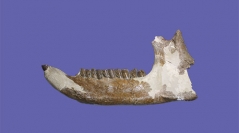

 Comptes Rendus Palevol
22 (36) - Pages 729-752
Comptes Rendus Palevol
22 (36) - Pages 729-752The paper provides an overview of the Chilotherium Ringström, 1924 fossils from Romania, which are recorded so far in three different Upper Miocene localities of the Eastern Carpathians Foreland: mammal localities of Reghiu, Bacău and Pogana. The fossils include a partial skull, several maxillary and mandible fragments and isolated teeth. They have been partially illustrated, but never described excepting the isolated teeth of Pogana. The previous assignments were confusing, ranging from Chilotherium schlosseri (Weber, 1905) and C. cf. sarmaticum for Reghiu specimens to an indeterminate species close to C. sarmaticum Korotkevich, 1958, C. kiliasi (Geraads & Koufos, 1990), and C. kowalevskii (Pavlow, 1913) for Pogana teeth. Based on descriptions and comparisons with other Chilotherium remains, all specimens from Romania can be referred to C. schlosseri. Chilotherium schlosseri is the most widespread species of the genus, ranging from Eastern Europe to Central Asia. The presence of this genus in Romania, and more globally in Eastern Europe, attests to a transition area between the more closed and wooded environments of Western Europe (where Chilotherium is absent) to the more open ones in Asia.
Late Miocene, Chilotherium, Rhinocerotidae, Romania